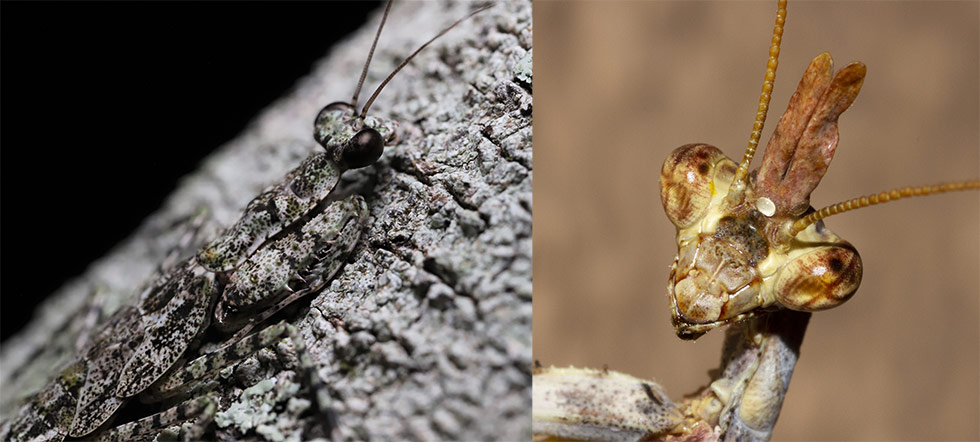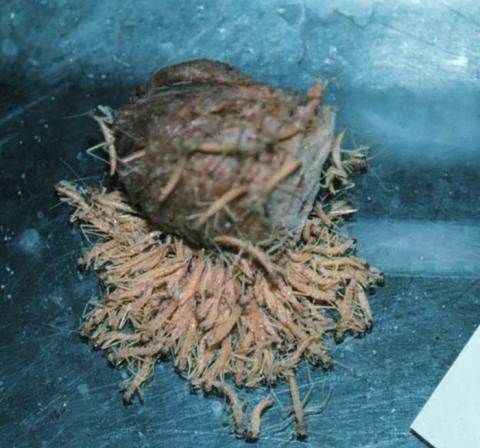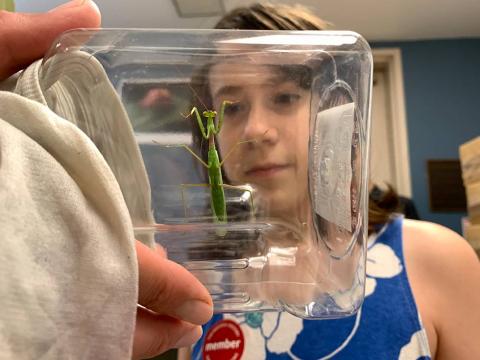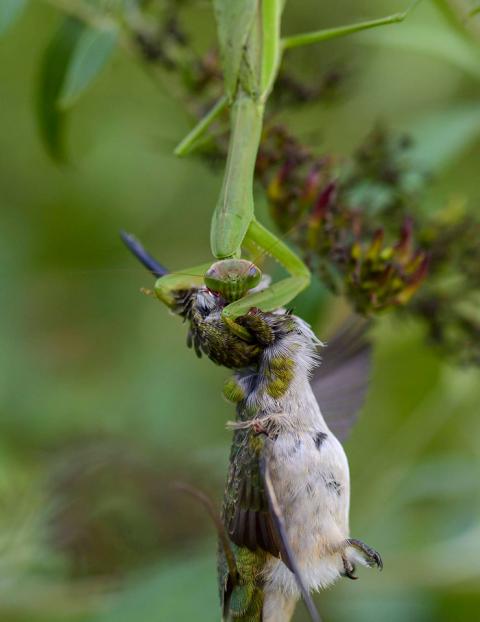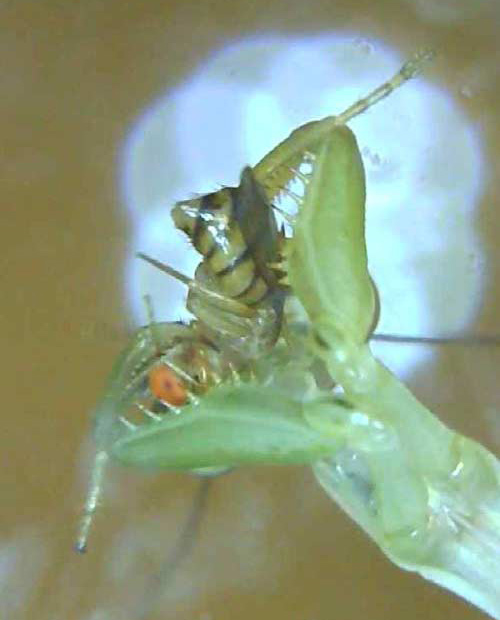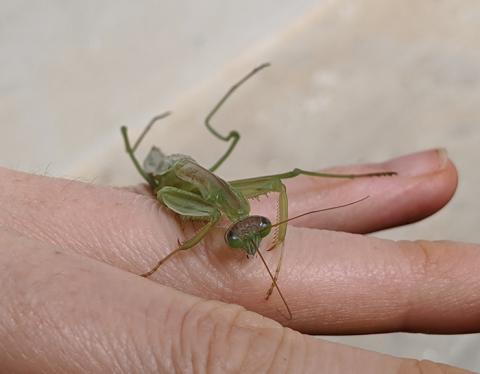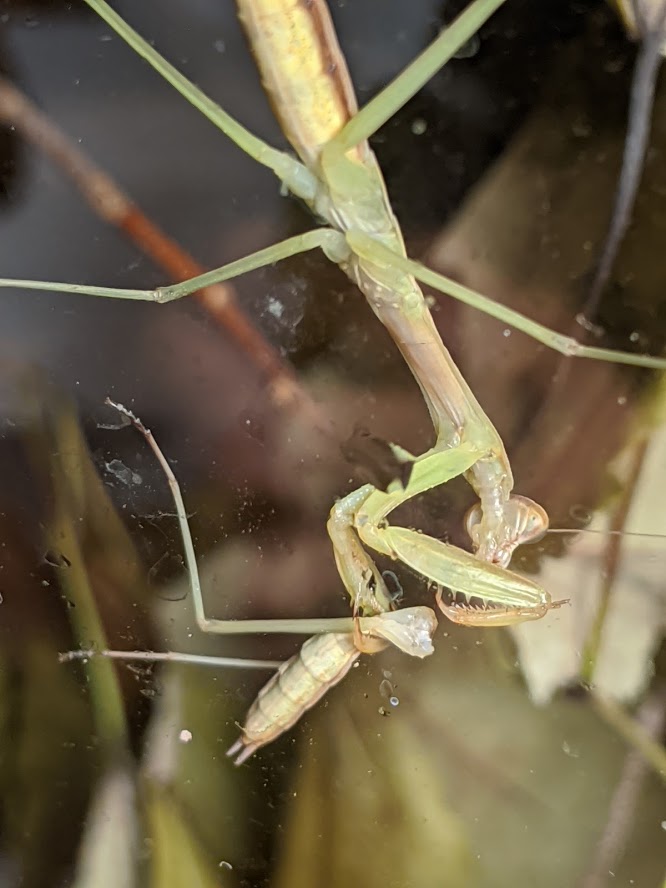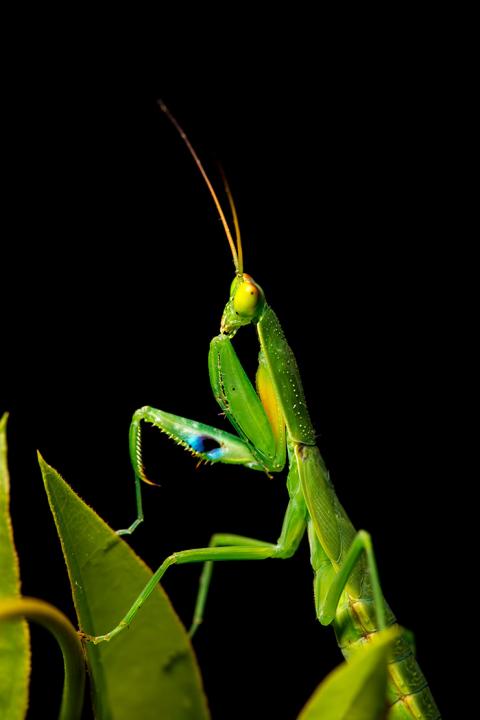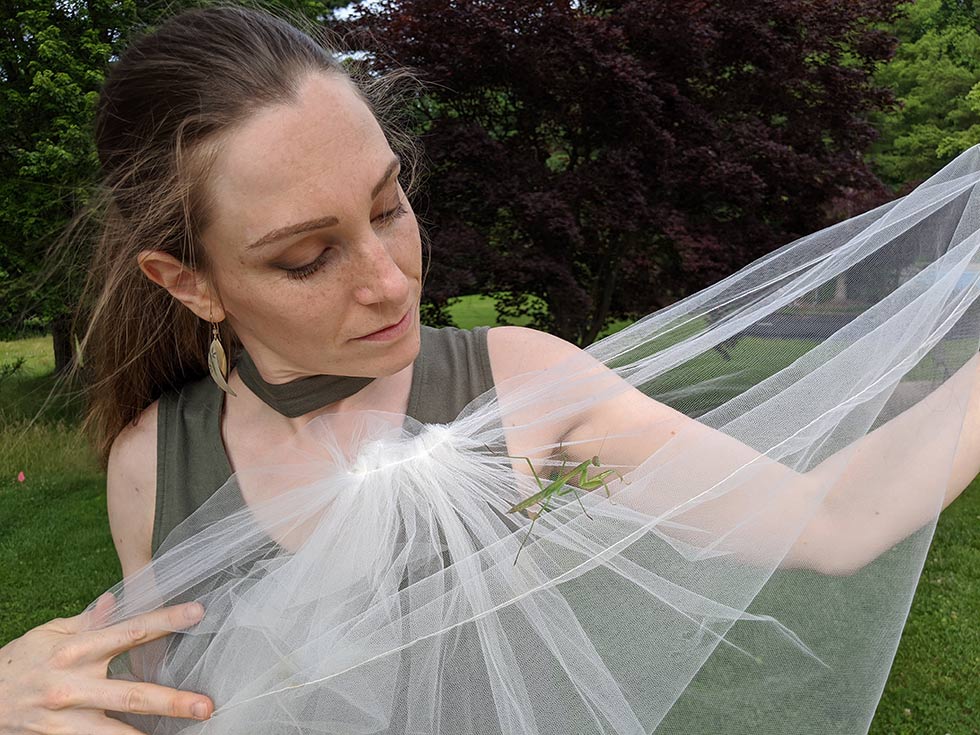Lessons About Love and Invasion from America's Foreign Mantises
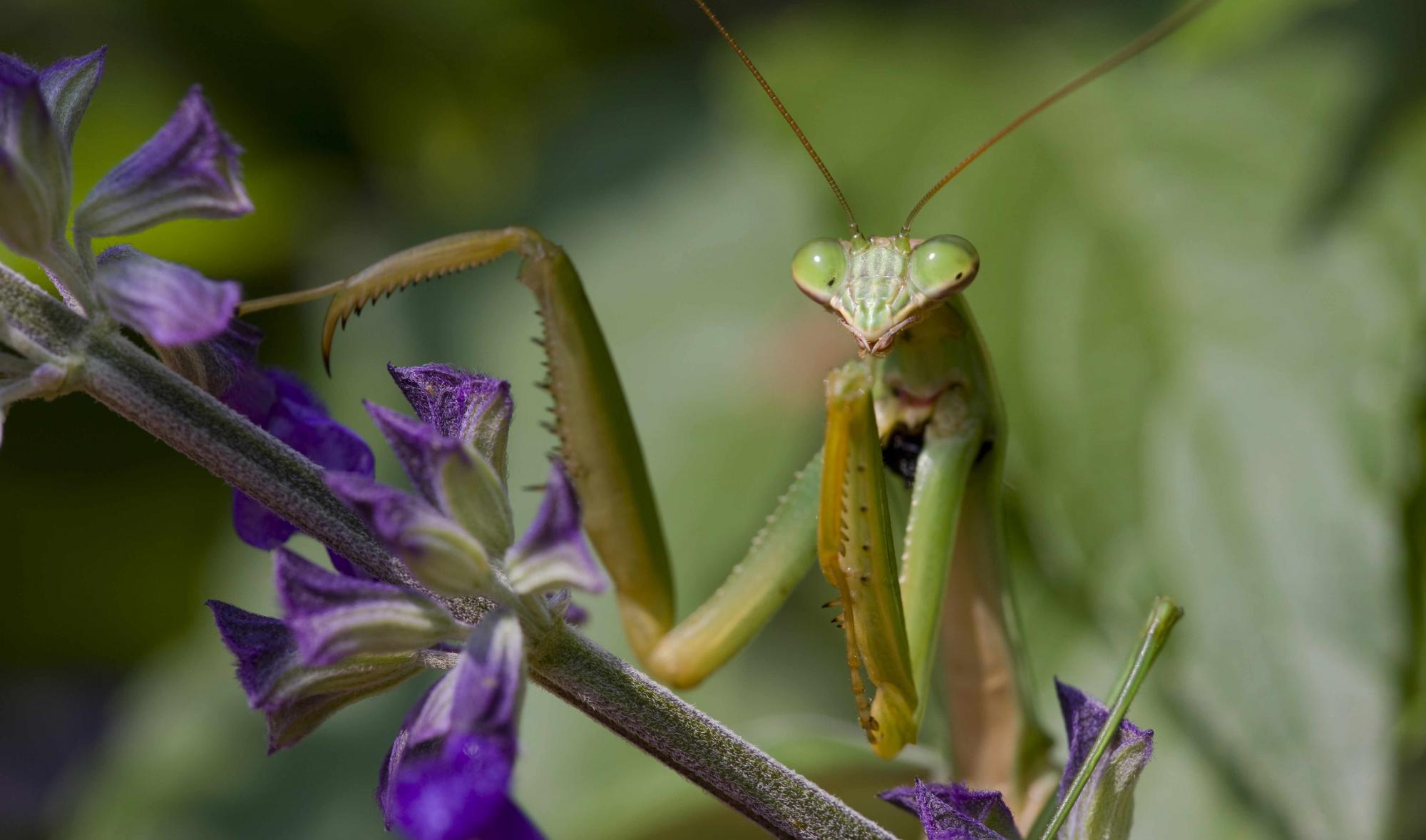
A Chinese mantis, Tenodera sinensis. This species is native to Asia but has lived in the United States for over a century.
Stubblefield Photography/Shutterstock
(Inside Science) -- The first official representative of North America's new African springbok mantis population was named Dog, and he was loved. Six-year-old Megan Reade plucked him off a rose bush in her yard last August and placed him in an observation jar while her mother Amy Reade and sister Anna Reade uploaded pictures to the citizen science app iNaturalist.
The family was still in their Los Angeles-area garden when Kris Anderson saw the pictures and sent an urgent message. Anderson studied mantises in college, and while he doesn't hold a formal research position or affiliation, he has written a book documenting the diversity of praying mantises in the U.S. and Canada. He spends about one to two hours a day identifying people's mantis pictures from his home in Las Vegas.
"This is a newly invasive species into the country," he wrote.
Reade and her daughters knew better than to release a nonnative species, so the mantis became a pet. He was joined the same day by a second springbok mantis named "Cat," and later by a third that Reade found scampering up her orange tree.
"They feel like June beetles," said Megan (now 7), referring to the figeater beetles she often plays with. "They prickle."
Anderson had noted a handful of previous African springbok mantis (Miomantis caffra) observations in California, but the population had yet to come to the attention of researchers at universities and museums. His message to Amy Reade started a chain of events that brought the three springbok mantises from the Reades’ backyard to the Natural History Museum of Los Angeles County, where researchers could study the newcomers and add them to the collection.
Dog and his kin represent the only African springbok mantis population not just in the United States, but anywhere in the Americas. Observations from people like Reade and her daughters now paint a clear picture of springbok mantises arriving in the U.S. in the last few years and establishing a breeding population around Los Angeles. While some researchers and mantis enthusiasts have expressed concerns about the newcomers, most experts I spoke with were not particularly worried -- largely because the U.S. is already full of foreign mantises.
"This mantis is going to have to fight its way up the totem pole past some other invasive mantids that got there ahead of it," said Douglas Yanega, an entomologist at the University of California, Riverside's Entomology Research Museum.
There are six other nonnative praying mantis species living in the U.S., and people can't seem to decide how they feel about them. At different times and places, nonnative mantises have been viewed as beneficial pest control, threats to native mantis species, beautiful exotic pets, or useless but relatively harmless additions to natural and agricultural landscapes.
The exotic mantises tend to be larger and easier to find than the country's 21 native species, and circumstantial evidence suggests they may have pushed natives out of many regions where they used to live. The largest by weight is the Chinese mantis, Tenodera sinensis. That's the one that chewed the head off a struggling Asian giant hornet, aka "murder hornet," in a video that went viral last month. If I had spoken with Megan and her family last fall, I might have avoided accidentally acquiring some 200 pet Chinese mantises of my own.
Mantis dilemmas
For me, the project started in mid-March when I was poking around a pond near my home looking for frogs and I accidentally broke off a twig with a tan lump on it. I knew it was a praying mantis egg case. I didn’t know anything else.
"Why not bring it back?" said my husband. So I did -- and then set it on the table in my study and forgot about it.
Three weeks later, I found centimeter-long hatchlings swaying and stumbling over every surface. It looked like a pile of rusty staples had come to life. I almost sat on four of them.
I fetched a 10-gallon terrarium tank from the garage, then coaxed the tiny things onto my hands and dropped them into the tank. When the bulk of them were captured, I belatedly set about identifying their egg case. It had the swooping, whipped-cream shape that marked it as the work of a Chinese mantis.
This presented me with a sort of ecological trolley problem. I didn’t want to kill them, but I knew that nonnative species can harm natural ecosystems. When the egg case was by the pond, it wasn't my responsibility. But now, if I released the babies, I might be actively harming the environment. I resolved to keep them in the terrarium until I could ask someone who really knew.
When Reade and her daughters found themselves in a similar situation last year, they reached out to the experts at the Natural History Museum of Los Angeles County. The family was already participating in the museum’s SuperProject, which asks citizen scientists to help document urban biodiversity. They soon heard back from Lisa Gonzalez, an assistant collection manager at the museum.
Gonzalez was eager to document the springbok mantis specimens and add them to the museum's collection. By that time, though, Megan was already attached to them. Her family kept the mantises until fall, near the end of their natural lives. When they finally relinquished Dog and the other surviving mantis at the museum in early October, Gonzalez promised to keep the insects alive until they passed away naturally.
"I started off as that same little girl that would go in my backyard and collect insects, and I would raise them," Gonzalez said. "I completely understood where she was coming from."
America’s newest mantis
According to Anderson, the first documented African springbok mantis in the U.S. was found near Long Beach, California, and reported to an online hobbyist forum in 2013. As of June 16, there are 19 records of the species in the U.S. on iNaturalist, the first one in 2018, all but two in Los Angeles County. The sightings include adults, egg cases and juveniles.
As for how they got here, it's possible springbok mantises were transported to the U.S. accidentally after laying their eggs on objects such as shipping containers. Still, most sources I spoke with suspect the pet trade. Mantises have become popular pets in recent years, and it's easy to buy egg cases over the internet.
Gonzalez understands the appeal of raising mantises, although she urges people not not to release exotic species into the wild.
"You make a connection with [mantises] just because of the way they turn their head and the way they're so visual," she said. "If you're offering them a prey item and they're hungry, they immediately turn and they look at it, and then they almost sort of vibrate, you know, like they're spring-loaded."
Now, researchers are tracking and documenting African springbok mantises in the U.S., watching to see whether they spread or die out. When species first colonize a new area, they are vulnerable to being killed off by random factors such as extreme weather events, noted David Ziolkowski Jr., an ecologist with the U.S. Geological Survey at Patuxent Wildlife Research Center in Maryland. But since the mantises have been observed regularly for two years, Mark Hoddle, an entomologist and director of the Center for Invasive Species Research at the University of California, Riverside, suspects they are here to stay.
If something does kill them off, it probably won't be humans. Government agencies and agricultural groups spend billions fighting nonnative species, but only when they think those species will cause severe economic or environmental harm.
"Something like a mantis really poses little economic threat to our agricultural industries," said Hoddle. "It's unlikely that there will be any sort of movement to eradicate Miomantis caffra."
Predators of everything
"Little economic threat" is faint praise compared to how people used to talk about nonnative mantises. In the 20th century, all mantises were generally viewed as "beneficial insects." They eat other insects, the reasoning went, and other insects eat crops and gardens, so they must be helping. Hardware stores and garden centers across the U.S. sold the egg cases of nonnative mantises for people to put in their yards.
Some gardening companies still sell Chinese mantis egg cases online, but using mantises for pest control appears to be less common now. In part, that's probably because there is no evidence that it works.
Mantises do kill plant-eating pests. They also kill virtually everything else. "They just eat whatever is moving and within their reach," said Michael Maxwell, a behavioral ecologist at National University in La Jolla, California.
Mantises often sit on flowers snatching things that come to pollinate them. When Maxwell studied native Stagmomantis limbata mantises living along a stream bank in California, he found that the largest single component of their diets was honeybees. And in a 2017 paper, Maxwell and colleagues discussed 147 documented cases of praying mantises catching birds -- mostly hummingbirds, which are also pollinators.
Larry Hurd, an ecologist at Washington & Lee University in Lexington, Virginia, takes advantage of mantises' penchant for pollinators when he goes collecting. In late summer, he said, he looks around the base of goldenrod flowers for butterfly wings discarded by the mantises above.
In addition to herbivores and pollinators, mantises eat predatory insects and spiders, including ones that might be more effective at controlling pests. Sometimes they don't even have to kill the predators to get rid of them.
In one remarkable experiment, Hurd's then-graduate student Matthew Moran released young Chinese mantises into plots in an abandoned cow pasture in Delaware. Around each plot, they placed two strips of sticky material that trapped any small creature walking across it. When the researchers found an insect or spider stuck on the outer strip, they inferred that it had been crawling into the plot; when they found something stuck on the inner strip, they assumed it had been trying to leave.
The findings showed that as soon as mantises arrived, spiders began to flee. At first, when the mantises were small, only little spiders fled; as the mantises grew and became capable of taking larger prey, the fleeing spiders got bigger.
"The wolf spiders will just kind of bravely run away," said William Snyder, an insect ecologist at the University of Georgia in Athens, who was not involved in the project.
Only a few studies have looked at the net effect of mantises on plant growth, said Hurd. Hurd and Moran did find that Chinese mantises modestly increased plant growth in a field in Delaware. But there's no reason to assume that would be the case in other situations, Hurd said. What research mostly shows is that the effects of mantises are unpredictable.
To illustrate how much mantises' impacts vary with time and place, Hurd told me about an experiment he conducted in Delaware. When he released hatchling Chinese mantises into a field early in the year, they dramatically reduced the aphid population, because at that time aphids were the only major food source available. But when he released mantises of the same age later in the year, they went for small spiders instead. The aphid population then exploded, with neither mantises nor spiders keeping it in check.
Raising monsters
The stories about mantises' indiscriminate appetites matched what I saw with my own mantis family. Within a few days of hatching, they lost their infant clumsiness and started moving with eerie grace. When I shook a jar of flightless fruit flies into the tank, it started a feeding frenzy.
Most of the mantises would go for the flies, sometimes grabbing one in each claw and alternating bites. A few mantises pounced on their siblings. The siblings were too big for them to finish, so they would eat their fill and toss away the dismembered scraps. After the second feeding, my husband and I started calling them "the monsters."
For such ferocious creatures, they had a lot of long, delicate body parts. Their back legs reminded me of blown glass drawn into impossibly fine threads. The mantises would bend themselves sideways, arch one long, long leg up and over, and gently groom down each leg segment, cleaning, tending, all the way to the tip.
When they molted, it took an eon of incremental tugging to draw those back legs free. Sometimes they got stuck, and the legs came out mangled. I saw mantises crawling on the bottom of the tank, dragging legs bent upward at terrible angles.
In mid-May, my mantises graduated to eating crickets. There were about two dozen of them left, and I still wasn’t sure whether they represented a threat to the environment. I took advantage of an interview with Maxwell to ask for advice.
Leaving them together in one tank might make sense when they're young and there are lots of them, said Maxwell. But if I wanted any of them to survive to adulthood, I would need to separate them into individual containers.
"Eventually you're going to have to get them all out of the big Thunderdome arena," he said.
On Maxwell's advice, I ordered a set of 32-ounce canning jars, the kind that screw closed with bands that are separate from the lids. I also ordered window screen material to use in place of the lids, so the mantises would have airflow and grippy surfaces to hang from.
On May 22, I found another mantis being eaten. I watched it struggle in its sibling’s claws, thinking how many hurdles it had survived already. Now that the mantises were larger, I could see every twist and contortion.
With coronavirus delays, the jars and window screens wouldn’t arrive until the following week. I scrounged the cabinets, fridge, and recycling bin, eventually coming up with six jars that might do. Enough for the largest mantises. What about mesh?
I had mesh. My wedding veil. I hadn’t actually worn it at my wedding, but I’d tried it on with my dress and practiced saying my vows, and I examined my feelings before making my decision.
"But it's your wedding veil," said my husband. Then he helped me cut it up.
Dangerous invaders, or harmless residents?
If you listen to popular environmental messaging, it’s easy to imagine that nature is divided into two teams: good, native species versus bad invasives. When I first adopted my mantises, I had a slightly more nuanced understanding. I thought there were three teams.
I saw nature as divided between native species, harmless nonnative species and invasive species. My ethical quandary hinged on whether my nonnative mantises qualified as invasive.
The term “invasive” is sometimes used to refer to any nonnative species, but technically it only applies to nonnative species that cause environmental harm. Some exotic species are devastating, taking over ecosystems and killing or outcompeting native species. Other exotics ease into new environments with barely a ripple.
Mantises won’t ever take over an ecosystem, in part because they don't reach very high abundance, said Maxwell. They never swarm like locusts. And because their diets are so diverse and variable, they generally don't have large impacts on any particular prey species, according to Snyder. If ecosystems are like Jenga towers, most researchers see mantises as loose blocks, able to slide in and out without toppling the overall structure.
But that doesn’t mean they’re completely harmless. The main concern with nonnative mantises in the U.S. is that they may displace mantises that have lived here for millennia. For the few enthusiasts who know and love those American species, the thought of losing them is tragic.
Just such a tragedy may have played out in New Zealand, featuring none other than our newly arrived African springbok mantises. Springbok mantises invaded New Zealand in the late 1970s, and as they moved in, the native New Zealand mantis, Orthodera novaezealandiae, disappeared.
The New Zealand mantis's demise may be partly the fault of its males, which find female African springbok mantises sexier than females of their own kind, according to research by Greg Holwell and colleagues at the University of Auckland in New Zealand. Female New Zealand mantises don't eat males that try to mate with them, but female springbok mantises often do, so native males that pick the wrong love interest end up offering themselves as food.
UC Riverside’s Hoddle was a child in Auckland, New Zealand, when springbok mantises spread through his neighborhood. He remembers when he stopped seeing the native species, and how he missed their unique color patterns.
"Beautiful dark blue spots on those forearms. Just a gorgeous color," he said. "Miomantis doesn't have those."
Still, New Zealand is an island, making it more vulnerable to ecosystem upsets than the mainland U.S. Moreover, Hoddle said it wasn't clear to him whether the New Zealand mantises have truly declined, or whether they have simply been pushed out of human-altered habitats and into more wild areas.
That's a problem with assessing the impacts of exotic species in the U.S., too. According to Snyder, exotic species often thrive in the very landscapes where humans are likely to run across them -- yards, cities and farmland. In natural habitats, the native species may be more abundant than we realize.
In the U.S., native mantises tend be less common in regions where nonnative mantises are frequently found, according to Yanega. He and Anderson believe nonnative mantises are harming native species, so they refer to the foreign mantises as invasive.
But Hurd and Moran aren’t so sure. Some of the foreign mantises have been here for a long time, and we lack data about where native mantises used to live before the foreigners arrived.
"[Invasive] is a pejorative that means harm has been demonstrated, and I don’t know of any hard evidence that any mantis has been tested to see if it has actually done some harm," Hurd wrote in an email.
So what does that mean for the mantises living in jars on my table? I had set out to discover whether they were bad for the environment. I was finding that they mostly seemed to be a lesson in the pitfalls of oversimplifying nature.
I definitely shouldn't transport them someplace where Chinese mantises aren't already found, Moran told me. But Chinese mantises have been in the U.S. for over a century. My neighborhood is already full of them. In Moran’s view, putting them back where I found them probably won't make any difference.
"I don't think you have any morality to worry about," he said. "You're not really going to do any harm."
In theory, then, I am free to take them outside, let them crawl into the bushes, and never see them again.
Today I saw one of them molt for the first time since I separated them into their own private jars. She emerged perfect. Soft and pale and huge. And she is a she; I can tell now, can see the plump feminine tip of her abdomen. She tilted her head to look at me through the mesh of my veil, and I gazed back into her iridescent eyes.
Maybe we belong together a while longer.
Editor’s note: The Reade family are participants in a citizen science effort called the SuperProject, not BioSCAN as this story initially stated. We regret the error.

